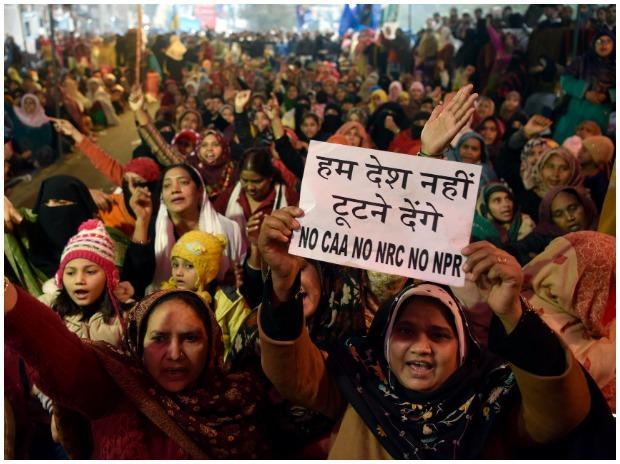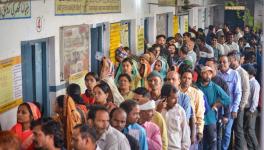At Shaheen Bagh, Protesters Seek More Than Slogans

With the Delhi Assembly election over, the venomous rhetoric let loose against Shaheen Bagh has also receded. The anti-CAA protesters are no longer a lethal weapon in the BJP’s polarising arsenal. It has generated a palpable sense of relief at the site of this emblematic protest that the BJP has lost all but eight of Delhi’s 70 Assembly seats.
Yet, Shaheen Bagh’s protesters, who have braved bullets and verbal abuse right through their sixty-day sit-in, now face the possibility of holding some sort of discussion with the government on the amended citizenship law. This has triggered the protesters to ask each other—albeit in hushed whispers—what the end-game of their agitation is.
One protester, a retired MTNL employee who has participated in Shaheen Bagh from day one, says, “A kind of boredom is settling in among the protesters. After being on the road for sixty days, naturally, they are tired.” An infrequent visitor to Shaheen Bagh would hardly notice the difference, but the crowds have also somewhat thinned after the Delhi election results. The site, tucked in a North-east corner of the Capital, is no longer bursting at the seams.
Muslims are sharply aware of the potential of the CAA-NPR-NRC triad to disenfranchise them. It is to prevent this outcome that they are protesting, regardless of the personal and professional burden the protests impose. For this very reason, they have started wondering whether they need to alter, so as to sharpen, the primary demand they have put to the government so far: to repeal the CAA-NRC-NPR.
On Sunday, if the protesters march to the residence of Home Minister Amit Shah to demand repeal of the CAA, how to avert the CAA-NRC-NPR will weigh heavily on many minds.
A protester who visits Shaheen Bagh regularly, and lives in upscale Greater Kailash Part-II, tells me that she think some protesters are heading for disillusionment in the absence of much-needed clarity. “People have come in by the thousands day after day to Shaheen Bagh (and Jamia Millia Islamia), but the organisers have failed to provide them a plan of action.” This has sparked ennui among some protesters, but, she hastens to clarify, “it does not imply that people are disinterested in the protest or its cause.”
After the numerous highs and lows of the last two months, Shaheen Bagh residents now want a clear plan of action from their ‘organisers’, including the dadis and nanis of the locality. “The rallying cry here is ‘hum kagaz nahi dikahyenge’—we will not show our papers—when the enumerators come for the NPR. However, there is no consensus on how to do this,” the protester from GK says.
Tedium is also a natural consequence of the heady days of January and early February. Now, the protesters fear that their movement has not progressed beyond rhetoric. For example, speaker after speaker has told them that the NPR is simply a backdoor for the NRC.
Then news trickled in from Hyderabad that posters have shown up which say that the NPR enumerators must be asked to “go back”, and that the government should remove seven recently-introduced questions in the NPR form, before the enumeration begins on 1 April. This has got the protesters at Shaheen Bagh to ask why the organisers of all the protest sites do not get together and form a joint strategy.
For, not all protesters at Shaheen Bagh become aware of what is going on at the other protest sites, and they are also unsure of what effect—or penalty—their refusal to share information with the NPR enumerators will have.
These enumerators will start seeking detailed information from each household on the date and place of their parent’s birth, passport details, driving licenses, PAN cards and Aadhaar cards. Activists have been saying that they will decline to share this information when, in fact, there is no guideline on how to actually do this.
Faizan Mustafa, a leading constitutional law expert, wrote in India Today that “…once the new data-set is in, NRIC will practically be just a click away. The NRIC rules are already in place and it is disingenuous of the government to now claim that it has not even been discussed.”
It was the Vajpayee government which, in a 2003 amendment to the Citizenship Act, framed the NRIC (or National Register of Indian Citizens) rules and also inserted section 14A in the act, which mandates the government to compulsorily register every citizen and maintain an NRIC. Mustafa further says, “However, since the parent act does not even mention it, NPR should be withdrawn and the reference to a population register deleted from these rules.”
When they hear of the legal implications, the protesters at Shaheen Bagh also start wondering what strategy they must adopt. Now that they have been out on the road for two months, they want their leaders, nebulous though they may be, to take their protest beyond just rousing slogans.
The waxing and waning of enthusiasm is not unique to Shaheen Bagh’s protesters, nor is it a rejection of its goals. When popular figures such as Bollywood director-producer Anurag Kashyap show up in solidarity, tremendously large crowds still gather. Moments like these reinvigorate agitator’s excitement and engagement, but they cannot substitute for a firmer sense of purpose.
Gyan Prakash, the author of Emergency Chronicles: Indira Gandhi and Democracy’s Turning Point has said in a recent interview with The Hindu that Shaheen Bagh and its spin-offs have no visible organisation, but they are “...more organic than the JP movement. Since there is no political force behind the current movement, what shape this will take remains an open question. Today, the younger leaders talk about Ambedkar, Dalits and the Muslim minority. [Hence] The social roots and potential of this movement are far greater than the JP movement”.
This potential is what draws crowds to Shaheen Bagh, explains Muhammad Sami, who lives here. “Thousands still come to hear speakers, attendance swells when a celebrity arrives, so the protest still enjoys unequivocal support,” he says.
Like many others, Sami also believes that the protest will not fade, for the local community is convinced that Muslims only have two choices: either head to the ‘concentration camps’ which they fear the BJP has planned for them or continue with their agitation.
From India’s IT capital Bangalore to Mumbai, the business capital, and in a hundred other big and small cities, protesters inspired by Shaheen Bagh have braved brute power and abuse but never let their spirit break. So far, the State has underestimated their will to power. Perhaps this is what will also get them across the next barrier.
The author is a writer and columnist. The views are personal.
Get the latest reports & analysis with people's perspective on Protests, movements & deep analytical videos, discussions of the current affairs in your Telegram app. Subscribe to NewsClick's Telegram channel & get Real-Time updates on stories, as they get published on our website.
























